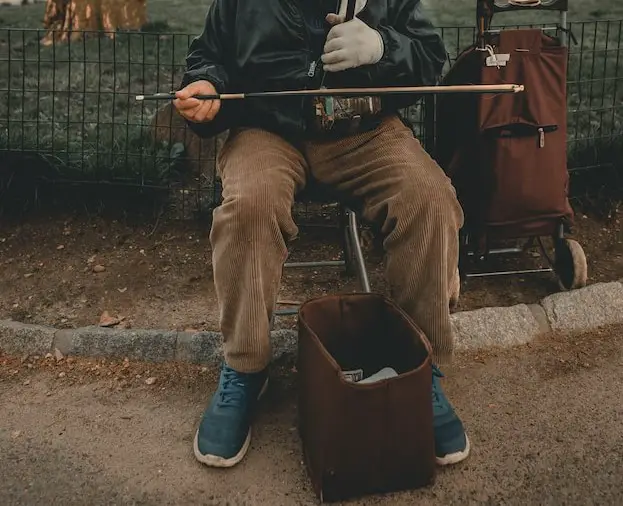Vagrant and hobo are both terms used to describe people who are homeless and travel from place to place, but there are some differences in their meanings. Vagrant generally refers to someone who is homeless and wanders from place to place without a specific destination or purpose, while hobo typically refers to a homeless person who travels to find work or better living conditions.
Who is a vagrant?
A vagrant is a person who is homeless and often wanders from place to place without a permanent home or regular employment. Vagrants may be forced into this lifestyle due to poverty, mental illness, addiction, or other difficult circumstances. The term “vagrant” can have negative connotations and is sometimes used to refer to someone who is seen as lazy or shiftless.
Who is a hobo?
(Photo by Clay Banks on Unsplash )

A hobo is a person who is homeless and travels from place to place in search of work or better living conditions. Unlike vagrants, hobos are often willing to work and will do odd jobs or seasonal work in exchange for money or food. Hobos have been a part of American culture for many years and are often associated with the Great Depression era when many people were forced to live as vagrants or hobos due to extreme poverty.
Vagrant Vs. Hobo – Key difference
The key differences between vagrants and hobos are:
Purpose: Vagrants wander from place to place without a specific destination or purpose, while hobos travel from place to place in search of work or better living conditions.
Attitude towards work: Hobos are often willing to work and will do odd jobs or seasonal work in exchange for money or food, while vagrants are not necessarily seeking work or opportunities.
Connotation: The term “vagrant” can have negative connotations and is sometimes used to refer to someone who is seen as lazy or shiftless, while “hobo” has a more neutral or even positive connotation, associated with a tradition of travel and adventure.
Lifestyle: Hobos often have a culture and lifestyle that centers around train-hopping and living off the land, while vagrants do not necessarily have a specific culture or lifestyle associated with their wandering.
The main differences between vagrants and hobos lie in their purpose for wandering, attitude towards work, connotation, and lifestyle.
Is a hobo in the same as a vagabond?
(Photo by Maarten van den Heuvel on Unsplash )

While hobo and vagabond are both terms used to describe people who are homeless and travel from place to place, there are some differences in their meanings.
The term “vagabond” generally refers to a person who travels from place to place without a permanent home, job, or income. Like vagrants, vagabonds may be forced into this lifestyle due to poverty, mental illness, addiction, or other difficult circumstances.
The term “hobo,” on the other hand, specifically refers to a homeless person who travels in search of work or better living conditions, and is willing to work odd jobs or seasonal work in exchange for money or food.
So while there is some overlap between the terms, a hobo is a specific type of vagabond who is looking for work while traveling.
Why is it called a hobo?
There are several theories as to why the term “hobo” came into use in the late 19th century. One theory suggests that the word is derived from the Spanish word hombre, meaning man. Another theory posits that the word comes from the Old English word for beggar, hodbald.
It’s also possible that the term “hobo” was simply a slang term used by American railroad workers in the 1800s. The workers used the term to refer to people who rode on trains without paying for a ticket. This practice was known as “riding the rods” or “riding the rails.”
Whatever its origins, the term “hobo” came to be associated with wandering vagrants in the early 20th century. Unlike vagrants, hobos were usually men who traveled in search of work. They often carried their belongings in a bindle (a sack or bundle) slung over their shoulder.
During the Great Depression, many hobos became homeless and took to riding freight trains in order to survive. This lifestyle was romanticized in popular culture, and hobos became something of an American icon.
How does hobo make money?
Hobo makes money through a variety of means, including begging, scavenging, and working odd jobs. While vagrants are often associated with homelessness and begging, there is a distinction between the two terms. A hobo is someone who chooses to live a nomadic lifestyle, often riding freight trains and hopping off at different stops to work odd jobs before moving on. This is in contrast to a vagrant, who is someone without a home or permanent address. While both groups may beg or panhandle for money, vagrants are more likely to do so out of necessity, while hobos may do so as a way to make some extra money on their journey.
Is it rude to say vagrant or hobo?
The terms “vagrant” and “hobo” can be seen as derogatory or insensitive, as they have historically been used to label and stigmatize homeless individuals. While the words themselves are not inherently offensive, they can carry negative connotations and suggest that homeless people are lazy, shiftless, or undesirable.
It is generally more respectful to use more neutral or descriptive language when referring to people experiencing homelessness. For example, terms like “homeless person,” “person experiencing homelessness,” or “unhoused individual” are more sensitive and less stigmatizing.
Ultimately, the most important thing is to treat homeless individuals with respect and compassion, and to avoid language that might further marginalize or stigmatize them.
What were the two types of vagrants?
Historically, vagrants were categorized into two types: “rogues and vagabonds” and “sturdy beggars.”
Rogues and vagabonds were considered to be people who were idle and wandering without a clear purpose. They were often seen as a threat to social order, and were punished by law enforcement.
Sturdy beggars, on the other hand, were seen as people who were willing to work but unable to find employment. They would often beg for money or food as a means of survival. While they were still seen as problematic by some, they were generally treated with more sympathy than rogues and vagabonds.
It’s worth noting that these categories were created in the past and are no longer commonly used. Today, people who are homeless or experiencing poverty are recognized as individuals who are facing complex social, economic, and health-related challenges.
Featured Image By – Rico Van de Voorde on Unsplash








